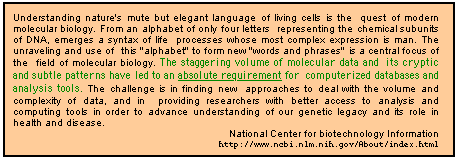COMPUTATIONAL BIOLOGY |
Course Description
 |
The ability to manipulate organisms genetically has been revolutionized in the last ten years. Biological information produced by this revolution is represented in many forms: sequence data, structural data, and functional data. These data can often be accessed and interpreted only with the help of computers. Data Mining is now an established tool for predicting structure and understanding function in genomics and proteomics. It is becoming impossible for molecular biologists and biochemists to do research without the aid of computer based tools. The advent of computational biology also offers new opportunities for those in chemistry, physics, mathematics and computer science.
This course is intended for students in molecular biology, cell biology, microbiology, physiology, biochemistry, chemistry, physics, mathematics or computer science. It is an introduction to the concepts, and the principal data bases and algorithms, of bioinformatics and structural biology/chemistry. Although emphasis is placed on practical applications, an understanding of the mathematical basis of the algorithms, and their strengths and weaknesses - and the important principles of molecular biology and structural chemistry which they model, is important. This course should enable students to access and analyze sequence and structure data, create and edit images of molecules, and present results in web pages, CHIME and Power Point formats.
Prerequisites: Biology 201 or 203; CIS 110 or 217; Math 260 and 221. Exceptions by permission of the instructor.
Glossaries of Biotechnology
and Genomics. As with any technical field, biotechnology
is replete with a terminology all its own. These are some glossaries
to terms you may not be familiar with.
|
|
Reference Sources on Molecular Biology, Genomics and Bioinformatics
|
|
TEXTS
|
|
|